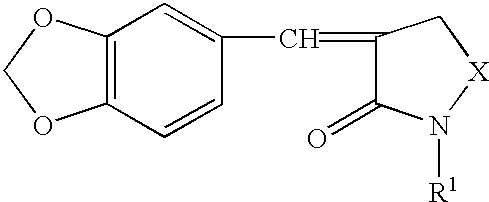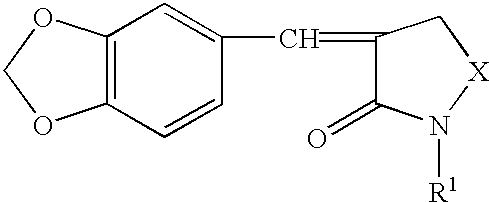Methods of treating cancer using a heat shock factor activity inhibitor
a technology of heat shock factor and activity inhibitor, which is applied in the direction of biocide, contraceptive devices, therapy, etc., can solve the problems of hsf activation process, hsf modification and signal transmission, and no specific drug has been found to suppress hsf specifically,
- Summary
- Abstract
- Description
- Claims
- Application Information
AI Technical Summary
Benefits of technology
Problems solved by technology
Method used
Image
Examples
example 1
Synthesis of Compounds 101 and 102
[0045]A solution of N-acetyl-2-pyrrolidone (70.0 g, 0.55 mol) and piperonal (82.0 g, 0.55 mol) in tetrahydrofuran (500 ml) was dropped into a suspension of sodium hydride (60% mineral oil suspension, 63.0 g, 1.57 mol) in tetrahydrofuran (1000 ml) while cooling on ice under an argon atmosphere, after which the reaction solution was stirred overnight at room temperature. The reaction solution was neutralized with dilute sulfuric acid, extracted with chloroform, washed with saturated saline, dried with sodium sulphate, and filtered, and then the solvent was distilled away under vacuum. The resultant reaction product was re-crystallized with 2-propanol, thereby obtaining Compound 101 (79.0 g, yield: 65%).
[0046]NMR (400 MHz, CDCl3) 3.03 (2H, m), 3.48 (2H, m), 6.03 (2H, s), 6.29 (1H, s), 6.86 (1H, d), 7.24 (1H, s), 7.49 (1H, d)
[0047]A solution of Compound 101 (82.0 g, 380 mmol) in formic acid (500 ml) was heat refluxed for 20 hours by using a Dean-Stark ...
example 2
Synthesis of Compounds 103 and 104
[0049]Compound 103 was obtained through a procedure similar to that used for Compound 101, while using N-acetyl-2-piperidone (77.5 g, 0.55 mol) and piperonal (82.0 g, 0.55 mol) as materials.
[0050]Compound 104 was obtained through a procedure similar to that used for Compound 102, while using Compound 103 (97.5 g, 380 mmol) as a material.
example 3
Expression Suppression Experiment Using Reporter Protein
[0051]A plasmid was produced in which a β-galactosidase gene was located downstream of a promoter region including the HSE sequence for HSP47. Chinese hamster ovary (CHO) cells were transfected with the plasmid to obtain stable transformant A. On the other hand, another plasmid was produced in which a β-galactosidase gene was located downstream of an SV40 early promoter which does not include the HSE sequence but has many other transcriptional factor control regions. Chinese hamster ovary (CHO) cells were transfected with the plasmid to obtain stable transformant B. These stable transformants were pre-treated with Compounds 101, 102 and 103 above and Compound C (1-acetyl-3-benzo-(1,3)dioxole-5-ylmethylene-pyrrolidin-2-one; this compound is represented by general formula (I) of the present invention wherein X is —CH2— and R1 is acetyl) in a CO2 incubator at 37° C. for 60 min. Then, the transformants were subjected to a heat shoc...
PUM
| Property | Measurement | Unit |
|---|---|---|
| Molar density | aaaaa | aaaaa |
| Fraction | aaaaa | aaaaa |
| Fraction | aaaaa | aaaaa |
Abstract
Description
Claims
Application Information
 Login to View More
Login to View More - R&D
- Intellectual Property
- Life Sciences
- Materials
- Tech Scout
- Unparalleled Data Quality
- Higher Quality Content
- 60% Fewer Hallucinations
Browse by: Latest US Patents, China's latest patents, Technical Efficacy Thesaurus, Application Domain, Technology Topic, Popular Technical Reports.
© 2025 PatSnap. All rights reserved.Legal|Privacy policy|Modern Slavery Act Transparency Statement|Sitemap|About US| Contact US: help@patsnap.com



